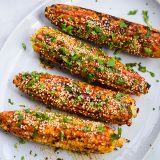During a visit to Ecuador, I was reminded that the rotisserie is a device that has been put to all sorts of creative uses around the world.
In Quito, a vast rectangular grill loaded with 10 rotating skewers on each side was in the service of grilled guinea pig, the national dish. Without much meat and on the gristly side, the charm of this specialty eluded me. But there was a certain fascination to watching 20 impaled critters turning slowly over a shallow bed of coals.
The Taiwanese food I saw on the rotisserie in Taipei, however, had more appeal. One stall at Raohe Street Night Market offered rotisserie corn. The long rows of ears were slathered with various coatings, some richly colored and thick, reminding me of corn dogs or candied apples; the corn’s exterior became the main attraction.
This was in keeping with the carnival atmosphere of a Taipei night market, where each brightly lit booth offered culinary entertainment, from cane juice presses and grilled squid to ice-shaving machines and large tandoor-style ovens for baking pork buns. All that was missing were teenage girls clutching giant teddy bears, blooming onions and fried sticks of butter.
When recreating the corn at Milk Street, we ran into problems at the start. A rotisserie is perfectly designed for basting; applying sauce to corn while it sits on the grill is another matter entirely. There was also the problem of translation. Joan, our guide in Taipei, got some details from the market’s corn vendor, but they were sketchy.
The two main ingredients seemed to be lard and sha cha sauce, the latter consisting of soybean oil, brill fish, dried shrimp, garlic, shallots and chilies. (Another ingredient often mentioned in recipes for the corn is soy paste, a thick form of soy sauce.) The lard is brushed on as an undercoat and allowed to cook for a couple minutes on the rotating corn. The sha cha sauce is then brushed on in layers as the corn cooks.
Since both lard and sha cha sauce were non-starters, we settled on a mixture of gochujang—the go-to sauce for Korean cooking—mixed with rice vinegar, Worcestershire and oyster sauces and toasted sesame oil.
Grilling corn tends to dry out the kernels, and the corn in Taiwan is starchier than the sweet corn we use here in the U.S., making our exposed ears even more susceptible to overcooking. So we started with unhusked corn, which we grilled, turning, for about 15 minutes. Off heat, once the ears were cool enough to husk, we basted them with our sauce, then briefly returned them to the heat to finish, eliminating the risk of the basting sauce burning. Though unconventional, a final sprinkle of sesame seeds and chopped cilantro just before serving added a fresh touch.




